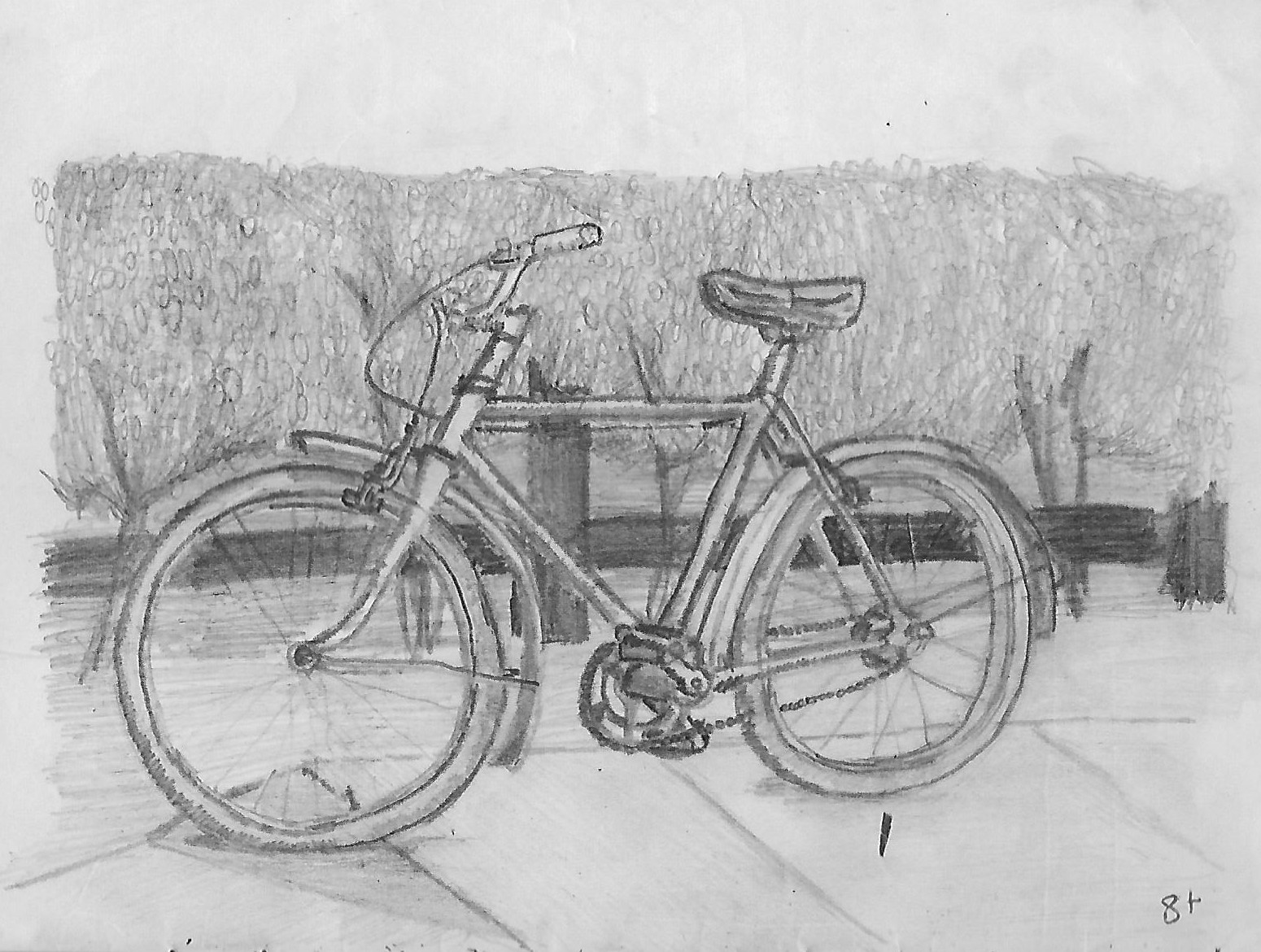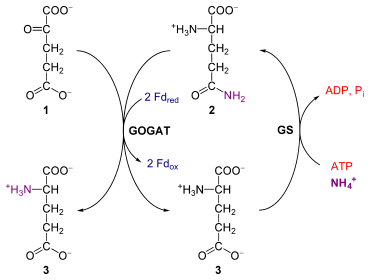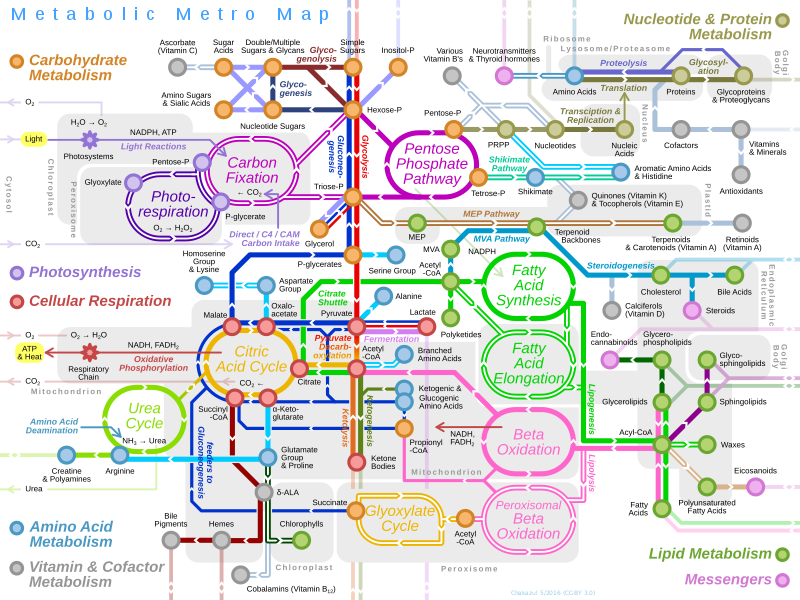From a Bicycle Paper Round to Metabolic Cycles
When I was 14 -15 years old, my first steady job was a paper round (i.e. deliver of newspapers to people's homes). I relied on my trusty steed, my bicycle, to accomplish this each morning before school:

Image from: Blast From the Past - My Old Art Books From High School (1965 - 1966) - Part 2
I was certainly interested in art but felt that a career in science might provide more financial security. I took a liking for biology in high school, and plant biology in particular. After high school I went to Manchester University to do a B.Sc. in Botany in 1970, and was particularly excited by plant physiology and biochemistry. I stayed at Manchester University (UK) to do my Ph.D. (1973-1976) on plant nitrogen assimilation (Rhodes et al. (1975)). Here I was introduced to my first metabolic cycle ... the glutamine synthetase/glutamate synthase cycle which turned out to be the primary pathway of ammonia assimilation in plants:

The glutamine synthetase (GS)/glutamate synthase (GOGAT) cycle. Image Source:.
1 = 2-oxoglutarate, 2 = glutamine, 3 = glutamate, Fd = ferredoxin, GS = glutamine synthetase, GOGAT = glutamine:2-oxoglutarate amidotransferase, or glutamate synthase
After my Ph.D, I did a post-doc (funded by the Science Research Council) at the University of East Anglia, Norwich (UK) (1976 - 1978) investigating nitrogen-15 assimilation in the duckweed (Lemna minor) and mathematically confirming the operation of the afore-mentioned cycle (Rhodes et al. (1980)).
Following this, I did a second post-doc in the USA (Plant Research Laboratory, Michigan State University, East Lansing, MI), got married, and took my first "real" job at Zoecon Corporation in Palo Alto, CA in 1980. Zoecon Corporation was run by Carl Djerassi (see his Wikipedia page) who led a very bright team of scientists investigating novel insect control strategies employing juvenile hormone analogs. In 1980 Zoecon expanded it's programs to discovery novel herbicides, and I was hired to assist chemists in assessing the toxicity towards plants and mode of action of compounds that they had synthesized. I worked there from 1980 - 1985, and throughout this time I maintained contact and collaboration with Dr. Andrew D. Hanson (Michigan State University), working on the pathway of synthesis of betaine in plants (Hanson and Rhodes (1983)).
In 1985 my wife and I moved to West Lafayette, IN when I joined The Department of Horticulture and Landscape Architecture at Purdue University. I worked there doing both research on plant metabolism and teaching plant physiology/biochemistry at the graduate and undergraduate levels until 2017 when I retired.
In both my research and teaching I would constantly have to deal with (and explain) metabolic cycles. In retirement I would now like to pass on some of my insight on these cycles gained over the last 45 years. Perhaps this may be of use to some young plant biologists in the steemit community?
So, I would like to begin a series of posts demystifying different metabolic cycles in plants, and explaining how these power plant growth, and provide all the nutrition for virtually all organisms on the planet. Some key metabolic cycles I will consider will include:
- The light reactions of photosynthesis
- The Calvin cycle of C3 photosynthesis
- The photorespiratory carbon and nitrogen cycles
- The glutamine synthetase/glutamate synthase cycle of ammonia assimilation
- The C4 photosynthesis cycle
- Crassulacean Acid Metabolism
- Starch biosynthesis and degradation
- Glycolysis and gluconeogenesis
- The citric acid cycle (TCA cycle, Krebs cycle) and its variants
- Lipid biosynthesis and catabolism
- The methionine transmethylation and methionine salvage pathways, coupled with the S-methylmethionine cycle (although I briefly discussed the transmethylation cycle in an earlier post (see: Why Did Popeye Consume Spinach?) I would like to elaborate on this further)
Where possible and appropriate, I will point out differences in plant metabolic cycles with those in other organisms. Many of these inter-linked pathways are captured in this image below, depicted as a "Metabolic Metro Map":

Metabolic Metro Map. Image Source:
Stay tuned as we take stops at different stations on this map and proceed to wander in circles.
Please feel free to leave comments or ask questions below.
Thanks for sharing about yourself, and I look forward to your future posts. I think we are both motivated to participate in Steemit for similar reasons. It sure beats writing grants and submitting manuscripts the old way!
Agreed. You can't talk about Popeye in grants and manuscripts submitted the old-fashioned way.
Interesting post, except I got a bit lost in the metro map.
That's what happens when you get a D grade in science for G.C.S.E.'S
Just think of the London underground but with metabolites rather than trains.
Good idea.